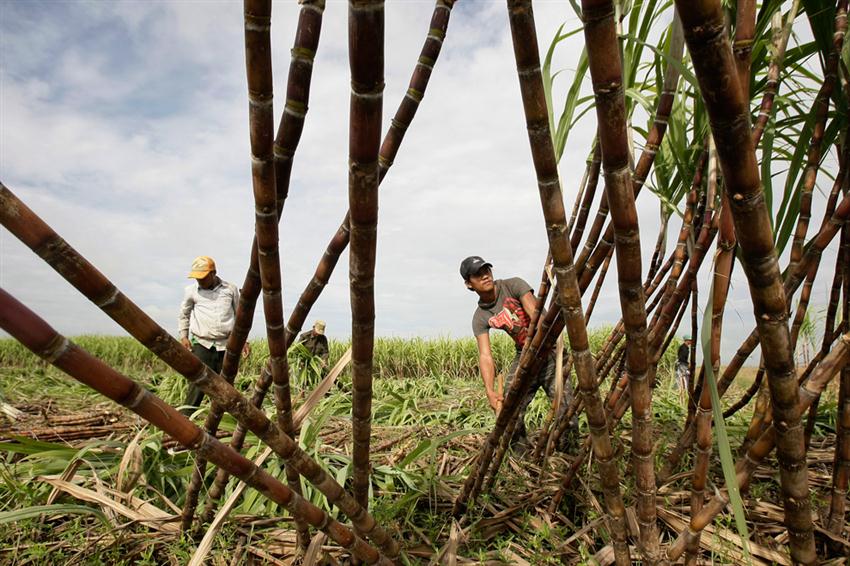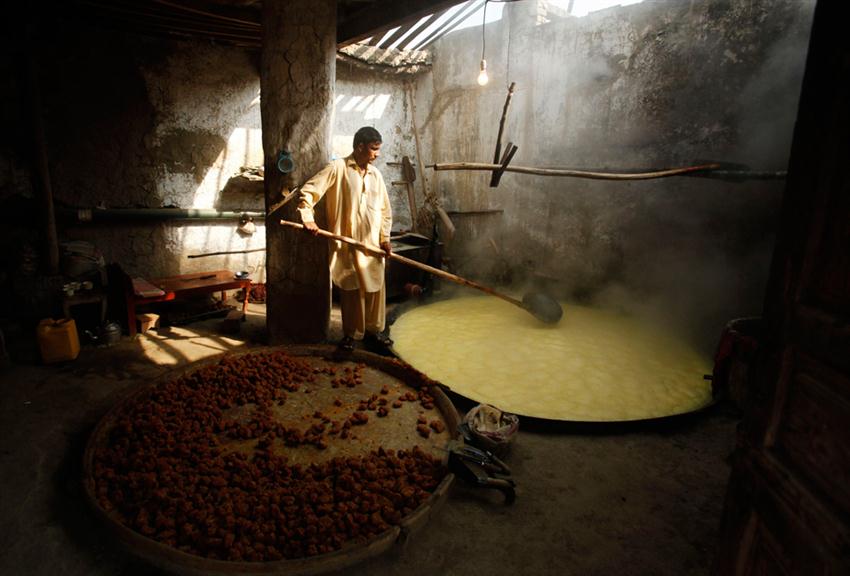Although modern techniques often bring sugar and salt to our
tables, these two simple treats for the palate are still harvested and
processed in traditional, if not ancient methods the world over. Over 160
million tons of sugar is produced annually in well over 100 countries, most of
it processed from cane in tropical countries. The world uses 240 million tons
of salt every year in everything from food to industrial applications. Gathered
here are images of the toils that result in two of our favorite flavors.
-- Lane Turner

A cut stem of sugar cane stands in a field in Saraburi province, Thailand on May 9, 2012. Thailand is the world's second-biggest exporter. (Dario Pignatelli/Bloomberg)
Indian
salt pan worker Bhartiben Rameshbhai breaks up the mineral from a flooded salt
pan near Odu village in the Little Rann of Kutch region in India on May 1,
2013. Recent unseasonal rains in the region have washed away tons of precious
salt there, ruining the livelihoods of hundreds. (Sam Panthaky/AFP/Getty
Images)
A
visitor walks past the Chamber of the Mirrors in the Nemocon salt mine on
September 26, 2012. The mine is one of Colombia's most popular tourist
attractions. (Jose Miguel Gomez/Reuters)
Antonio
Noguera boils the water extracted from mangrove swamps at a pool to process
kitchen salt in a salt mine in Colorado de Abangares, Guanacaste, Costa Rica on
April 11, 2013. People work in temperatures between 35 and 40 Celsius for 122
dollars a month. (Jeffrey Arguedas/EPA)
The
salt field at Palibelo village on the outskirts of Bima, Indonesia lies
tranquil on November 22, 2012. (Beawiharta/Reuters)
A man
prays in a Mosque made up of salt rock at the world's second largest salt mine
in Khewra, Pakistan on April 20, 2013. The mine is Pakistan's oldest salt mine
and a major tourist attraction, drawing up to 250,000 visitors a year. Its
history dates to 320 BC following its discovery by Alexander's troops, but
trading began in the Mughal era. The main tunnel was developed during British
rule in 1872. The mine produces more than 350,000 tons a year. (Omer
Saleem/EPA)
A
worker shows flower of salt, also known as the caviar of salt, in the saltworks
near Nin, Croatia on August 24, 2012. It appears at the sea surface as a thin
layer of salt flakes, like flower petals, which are collected manually with
micron sieves. Price for this kind of salt reaches 50 euros per kilogram.
(Hrvoje Polan/AFP/GettyImages)
Smoke
rises from the chimney of the sugar factory in Plattling, Germany on October 9,
2012. (Armin Weigel/AFP/GettyImages)
An
Afghan worker prepares traditional sweets at a factory on the outskirts of
Jalalabad on November 25, 2012. (Noorullah Shirzada/AFP/Getty Images)
A
worker burns sugar cane waste, part of the process in making biochar, at the
Eco Fuel Africa factory in Lugazi, Uganda on January 29, 2013. The process
produces a powder which can be used as an organic fertilizer or compressed for
use as a bio fuel which burns longer than charcoal. (Michele Sibiloni/AFP/Getty
Images)
A man
works on salt beds in Pangasinan province, Philippines on May 6, 2013.
Salt-making is a major source of livelihood for the province's coastal towns.
(Aaron Favila/Associated Press)
A woman
throws out soil after collecting salt from it in Djegbadji, Benin on January
11, 2013. Artisanal salt farmers here dig off the top layer of soil near their
homes then filter water through the dirt to draw out salt. They later boil the
water to collect the salt. (Sunday Alamba/Associated Press)
A
worker tests the quality of ethanol samples at a processing facility near
Sertaozinho, Brazil on August 24, 2012. Some 48.5 percent of all the cane
processed will be directed to sugar at the expense of ethanol. (Dado
Galdieri/Bloomberg)
A
Cambodian man carries palm juice for making sugar during harvesting season in
Tuol, Cambodia on December 13, 2012. (Heng Sinith/Associated Press)
Local
farmers cut sugar cane at Chea Khlang commune's field in Prey Veng, Cambodia on
September 1, 2012. (Heng Sinith/Associated Press)
A
worker pushes a wagon full of salt at the Ston Saltworks in Ston, Croatia on
July 31, 2012. The Ston Saltworks are the oldest and best preserved salt works
from Mediterranean history, with technique dating from the time of the Republic
of Dubrovnik. (Antonio Bronic/Reuters)
Guillermo
Castillo, 60, works on a valve that regulates the passage of sugar cane juice
at a processing plant in Jaronu, Cuba on September 8, 2012. (Franklin
Reyes/Associated Press)
Workers
collect salt in a pool at the salt mine in Salinas, Dominican Republic on July
28, 2012. The Salinas mines have been a source of salt since the time of the
conquest. Workers earn about $150 for a month's work. (Ricardo
Rojas/Reuters)
A
worker walks in a salt field in Palibelo village, Indonesia on November 22,
2012. (Beawiharta/Reuters)
Men
work at a sugar cane plantation in Siribala, Mali on January 24, 2013. (Joe
Penney/Reuters)
A
farmer from the Nueva Jerusalen sect rides his donkey through a sugar cane
field in Nueva Jerusalen, Mexico on September 26, 2012. (Alan
Ortega/Reuters)
A woman
harvests sugarcane at the Montelimar sugar mill on the outskirts of Managua on
December 31, 2012. Nicaragua plans to produce some 1.5 million short tons of
sugar. (Oswaldo Rivas/Reuters)
A man
makes brown sugar at his house on the outskirts of Peshawar on November 6,
2012. (Fayaz Aziz/Reuters)
Blocks
of panela, solid chunks of unrefined whole cane sugar obtained from the boiling
and evaporation of sugarcane juice, sit in a barrel at a sugar mill in
Tepetitan, El Salvador on February 26, 2012. (Juan Carlos/Bloomberg)
Pools
of salt form patterns at the Maras mines in Cuzco, Peru on August 29, 2012.
(Janine Costa/Reuters)
A
worker carries a bag of salt through pools of salt at the Maras mines in Cuzco,
Peru on August 29, 2012. The Maras mines have been a source of salt since
ancient pre-Incan civilizations and now comprise about 3,000 small pools
constructed on the slope of a mountain in the Urubamba valley in the Andean
region of Cuzco. (Janine Costa/Reuters)
Roads
intersect at a Rio Tinto Group salt operation in Dampier, Australia on August
20, 2012. (Carla Gottgens/Bloomberg)
Farmers
harvest sugarcane in a field in Yomitan Village, Okinawa Prefecture, Japan on
February 24, 2012. (Tomohiro Ohsumi/Bloomberg)
A
worker drinks water from a kettle as he harvests sugar cane in Sidoarjo,
Indonesia on September 19, 2012. (Sigit Pamungkas/Reuters)
Mine
operational manager Arnaud Tamborini takes a sample of salt for analysis on the
trolley in the salt mine in Bex, Switzerland on December 4, 2012. (Denis
Balibouse/Reuters)
A man
uses wooden rafts to transport pieces of salt rock after extracting them from
the bed of Lake Katwe in Uganda on January 29, 2013. The rock is extracted
three times a week, usually by men who work from dusk to dawn, paid two dollars
for every 220 pounds of salt rock sold. (James Akena/Reuters)
A man
smiles as he extracts salt rock from the bed of Lake Katwe in Uganda on January
29, 2013. (James Akena/Reuters)































No comments:
Post a Comment